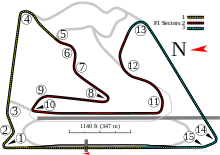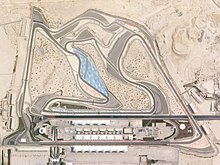
The 2017 Azerbaijan Grand Prix was a Formula One motor race that was held on 25 June 2017 at the Baku City Circuit in Baku, Azerbaijan. The race was the eighth round of the 2017 FIA Formula One World Championship, and was the maiden running of the Azerbaijan Grand Prix as a round of the Formula One World Championship. It was the second time that a race was held at the circuit and the second time that a Grand Prix was held in Azerbaijan.

The Ferrari SF70H is a Formula One racing car designed and constructed by Scuderia Ferrari to compete in the 2017 Formula One season. It was driven by Sebastian Vettel and Kimi Räikkönen. The car made its competitive début at the 2017 Australian Grand Prix, where it finished first and fourth in the hands of Vettel and Räikkönen, respectively. In keeping with his tradition of giving his cars female nicknames, Vettel named his SF70H "Gina".
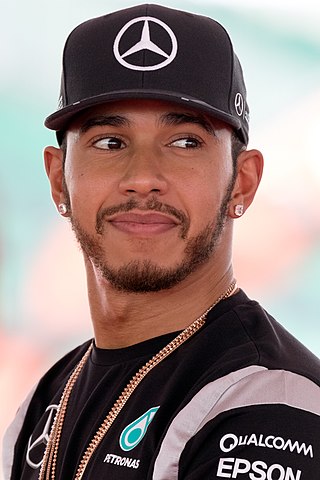
The 2019 FIA Formula One World Championship was the motor racing championship for Formula One cars which marked the 70th running of the Formula One World Championship. It is recognised by the governing body of international motorsport, the Fédération Internationale de l'Automobile (FIA), as the highest class of competition for open-wheel racing cars. Starting in March and ending in December, the championship was contested over twenty-one Grands Prix. Drivers competed for the title of World Drivers' Champion, and teams for the title of World Constructors' Champion. The 2019 championship also saw the running of the 1000th World Championship race, the 2019 Chinese Grand Prix.

The 2018 Azerbaijan Grand Prix was a Formula One motor race held on 29 April 2018 at the Baku City Circuit in Baku, Azerbaijan. The race was the 4th round of the 2018 Formula One World Championship, the 2nd running of the Azerbaijan Grand Prix as a round of the Formula One World Championship and the 3rd time the Baku City Circuit was being used to host a Formula One race.

The Mercedes AMG F1 W09 EQ Power+ was a Mercedes-Benz Formula One racing car designed and developed under the direction of James Allison, Aldo Costa, Mark Ellis, John Owen, Loïc Serra, Mike Elliott, Jarrod Murphy and Eric Blandin to compete during the 2018 Formula One World Championship. The car was driven by four-time World Drivers' Champion Lewis Hamilton, and Valtteri Bottas, both of whom remained with the team for a sixth and a second season, respectively.

The 2021 FIA Formula One World Championship was a motor racing championship for Formula One cars which was the 72nd running of the Formula One World Championship. It is recognised by the Fédération Internationale de l'Automobile (FIA), the governing body of international motorsport, as the highest class of competition for open-wheel racing cars. The championship was contested over twenty-two Grands Prix, and held around the world. Drivers and teams competed for the titles of Formula One World Champion Driver and Formula One World Champion Constructor, respectively.

The Mercedes AMG F1 W10 EQ Power+ is a Formula One racing car designed and developed by Mercedes-Benz under the direction of James Allison, John Owen, Mike Elliott, Loïc Serra, Ashley Way, Emiliano Giangiulio, Jarrod Murphy, Eric Blandin and Aldo Costa, to compete during the 2019 Formula One World Championship. The car was driven by Lewis Hamilton, and Valtteri Bottas, both of whom remained with the team for a seventh and a third season, respectively.The team’s reserve driver was Esteban Ocon, coming from Force India.

The 2021 Azerbaijan Grand Prix was a Formula One motor race held on 6 June 2021 at the Baku City Circuit in Baku, Azerbaijan. The race, the sixth round of the 2021 Formula One World Championship, marked the fourth running of the Azerbaijan Grand Prix, and the fifth time the country had hosted a Grand Prix, having also held the 2016 European Grand Prix.

The 2021 Hungarian Grand Prix was a Formula One motor race, held on 1 August 2021 at the Hungaroring in Mogyoród, Hungary. It was the eleventh round of the 2021 Formula One World Championship, and it was won by Esteban Ocon for Alpine-Renault. The win was Ocon's first in Formula One, the first win for the Enstone-based team since the 2013 Australian Grand Prix, and the first win for a Renault-badged engine since the 2014 Belgian Grand Prix, with Hamilton and Carlos Sainz Jr. completing the podium after Sebastian Vettel was disqualified from second. Pierre Gasly earned the fastest lap, while Williams scored their first double points finish since the 2018 Italian Grand Prix and their first points of any kind since the 2019 German Grand Prix.
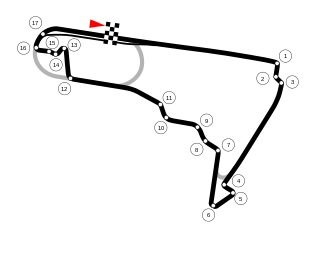
The 2021 Mexico City Grand Prix was a Formula One motor race, held on 7 November 2021 at the Autódromo Hermanos Rodríguez in Mexico City. The race was the 18th round of the 2021 Formula One World Championship and marked the 21st edition of the Mexican Grand Prix, which was run under the name Mexico City Grand Prix for the first time, acknowledging the sponsorship support of the government of Mexico City.
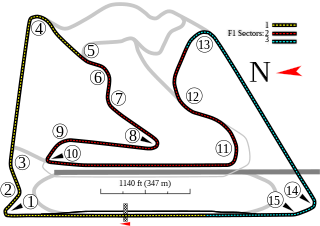
The 2022 Bahrain Grand Prix was a Formula One race that was held on 20 March 2022 at the Bahrain International Circuit. Contested over 57 laps, it served as the season opener of the 2022 Formula One World Championship and was the eighteenth running of the Bahrain Grand Prix.

The 2020 Spanish Grand Prix was a Formula One motor race held on 16 August 2020 at the Circuit de Barcelona-Catalunya in Montmeló, Spain. The race was the sixth round in the 2020 Formula One World Championship, and took place one week after the previous round, the 70th Anniversary Grand Prix.

The 2020 Sakhir Grand Prix was a one-off Formula One motor race that took place on 6 December 2020. The race was contested over 87 laps of the 'Outer Circuit' configuration of the Bahrain International Circuit in Sakhir, Bahrain. It was the first, and currently only, Formula One race on this track configuration. The race was the sixteenth and penultimate round in the 2020 Formula One World Championship and the second of two back-to-back races in Bahrain, with the Bahrain Grand Prix having taken place on the 'Grand Prix' configuration of the circuit one week beforehand. The race also marked the first, and thus far only, running of the Sakhir Grand Prix.

The 2020 Abu Dhabi Grand Prix was a Formula One motor race held on 13 December 2020 at the Yas Marina Circuit in Abu Dhabi, United Arab Emirates. The race was the seventeenth and final race of the 2020 Formula One World Championship. Red Bull driver Max Verstappen won the race and led every lap from pole position, followed by Mercedes drivers Valtteri Bottas and Lewis Hamilton who completed the podium. Red Bull Racing got their first victory at Yas Marina in seven years. McLaren secured third place in the Constructors' Championship which saw them score their highest finish in the Constructors' Championship since 2012. This also meant that for the first time since 2015, a team other than Mercedes, Ferrari, and Red Bull finished in the top three in the Constructors' Championship. This race also marked the last time the original configuration of the Yas Marina circuit which had been used since the first Grand Prix at the venue in 2009 was used by Formula One. Grands Prix would be held on a revised layout from 2021 onwards.

The 2021 Saudi Arabian Grand Prix was a Formula One motor race, held on 5 December 2021 at the Jeddah Corniche Circuit, in Saudi Arabia. The inaugural Saudi Arabian Grand Prix, it was the 21st round of the 2021 Formula One World Championship.

The 2021 Austrian Grand Prix was a Formula One motor race held on 4 July 2021 at the Red Bull Ring in Spielberg, Austria. The race was the ninth round of the 2021 Formula One World Championship, and the 35th running of the Austrian Grand Prix as well as the second of two consecutive races to be held at the Red Bull Ring with the Styrian Grand Prix held the week before at the same venue.

The 2021 Emilia Romagna Grand Prix was a Formula One motor race which took place on 18 April 2021 at the Autodromo Internazionale Enzo e Dino Ferrari in Imola, Italy. The race, held in wet conditions, was the second round of the 2021 Formula One World Championship, and the second Emilia Romagna Grand Prix.

The 2021 French Grand Prix was a Formula One motor race which took place on 20 June 2021 at the Circuit Paul Ricard in Le Castellet, Var. The 53-lap race was the seventh round of the 2021 Formula One World Championship. It was the 61st time the French Grand Prix had been included as a round of the world championship since the inception of the series in 1950.

The 2021 Styrian Grand Prix was a Formula One motor race that took place on 27 June 2021 at the Red Bull Ring in Spielberg, Austria as the eighth round of the 2021 Formula One World Championship. It is the second and final Styrian Grand Prix, and the thirty-fourth Grand Prix held at the venue. The event was added to the schedule after other races were cancelled because of the COVID-19 pandemic, forming the second leg of a series of three races on back-to-back weekends. The race was won from pole position by Red Bull Racing driver Max Verstappen, who led every lap of the race. Lewis Hamilton, driving for the Mercedes team, finished second and set the fastest lap, with his teammate Valtteri Bottas finishing third.

The 2021 Turkish Grand Prix was a Formula One motor race, held on 10 October 2021 at Istanbul Park in Tuzla, Istanbul. It was the sixteenth of twenty-two rounds of the 2021 Formula One World Championship. This was also the last Turkish Grand Prix, as the race had not been contracted for the 2022 season and beyond.
